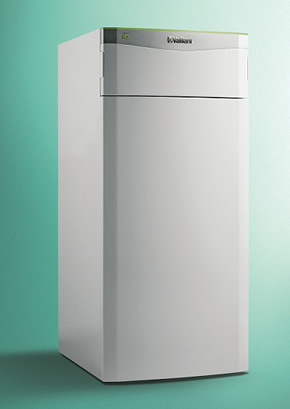
Renewable technologies need to be part of the energy conversation
Despite the Government’s plans to reform the Renewable Heat Incentive, and continue to at least 2020/21, reports suggest that the UK will still struggle to meet its stated target of delivering 15% of total energy through renewable sources by 2020.
John Bailey, commercial & renewable systems sales director for Vaillant, discusses how renewable heating technologies should become a key consideration for specifiers and facilities managers when considering heating and hot water solutions for commercial buildings…
Last November, the Government shared its plans to reform the Renewable Heat Incentive. However, it is only recently that they have shared details of what these reforms entail. As well as changes to the domestic RHI, which will see the introduction of heat limits to prevent larger properties from claiming more funds, the non-domestic RHI will now include introducing tariff guarantees for heat pumps and large combined heat and power biomass sites.
This is an encouraging step and confirms that renewable and hybrid systems need to be a part of the UK’s commercial energy mix to help reach its energy targets.
However, if organisations are only installing these systems to tick boxes, it will not be enough: no matter how efficiently the energy is produced, it defeats the object of the exercise if the building is leaky. It is imperative that building managers take an holistic approach to energy conservation if there are to be real improvements in how we use the energy we produce.
When assessing the initial outlay of a different kind of installation, it is no surprise that many building managers choose to replace their existing heating and hot water systems with something similar to their existing plantroom. It is familiar, after all, and means that no other modifications to the building are necessarily needed.
Specifying renewable technologies
What is vital at the planning stage of replacing or specifying a commercial heating and hot water system is a thorough lifetime cost analysis (including fuel usage), which includes ensuring the fabric of the building is optimally designed so that the energy that is being produced is being used with utmost efficiency.
The initial remit of the RHI was to address this particular issue by offering an investment payback for fitting a renewable heating and hot water system as well as the measures needed to ensure that the full benefits of such a system could be realised, i.e. by better insulating the fabric of the building.
However, the lack of publicity surrounding the scheme has resulted in a fundamental lack of understanding. by businesses and by the general public, as to what the scheme could deliver and how to access the funds available.
When it has been researched, it has prompted homeowners, landlords and businesses (albeit in small numbers) to consider the installation of available green heating technologies to not only drive a revenue stream through their energy source, but also access the undoubted benefits of longer-term cost and carbon savings.
While any uptake of renewable technology is to be welcomed, figures show that a significant proportion of the commercial RHI-funded renewable energy installations that have occurred in the past four years, have utilised biomass-based solutions. This has not necessarily been the application of best practice or, in many cases, the specification of the most appropriate sustainable technology solution.
Consideration needs to be given regarding the maintenance of a biomass boiler as well as the transportation of the fuel (which is often sourced overseas) as well as the CO2 emissions related to burning the fuel.
All of this contributes to an increased carbon footprint that negates any potential emission savings gained by sustainable technology on the ground. Indeed, the potential dilution of future RHI funding could help by removing or reducing an artificial incentive that has helped indirectly in the specification of a technology when it is not wholly appropriate for certain installations.
In addition, with the vast majority of current commercial installations remaining boiler-based, we might ask to what degree the RHI funding initiative has actually succeeded in turning renewable sceptics into converts? Where doubts remain as to the effectiveness of renewable systems, a hybrid solution can offer a good degree of reassurance.
Cost considerations and the refurbishment opportunity
Despite the welcome fall in the wholesale cost of energy over the past months, for many, energy bills still remain near the top of the agenda. Targets for reducing carbon emissions and alleviating fuel poverty still exist. In addition, the cost of supplying the energy required to operate a large commercial building can make it one of the largest areas of expenditure and, as such, has to influence the selection of a heating solution that can help minimise costs.
There are already numerous examples of major refurbishment projects that have been enhanced through ground source heat pump renewable specification. The technology is delivering a tangible return on investment, both in terms of cost savings for commercial and public building owners and landlords, as well as providing convenience and easeof- use to building users and tenants.
Practical and proven solutions
At Vaillant we have invested considerable resources into the ongoing development of renewable, boiler and hybrid heating solutions that will satisfy the priorities of commercial building specifiers and facilities managers. Issues of reliability, proven efficiency, cost savings and low maintenance commitments are crucial areas in which renewable technologies must prove their worth.
Most recently Vaillant has developed the flexoTHERM heat pump solution that can connect to three different sources – ground, water or air offering a much more flexible approach to renewable heat pump systems. At its heart lies outstanding performance, minimal environmental impact and flexibility, which makes it one of the most energy efficient heat pump range on the market, with the Sensonal Coefficient of Performance or SCoP as high as 5.82.
Tomorrow’s technology is here today. Make sure renewables are part of your energy conversation.
Find out more in the June issue of ABC+D Magazine
Latest news

19th April 2024
ASSA ABLOY: Access solutions can impact sustainability performance across the full life-cycle of a building
Embedding sustainability within any organisation requires a broad, strategic perspective. Scrutiny should include the physical infrastructure itself: According to the IEA, buildings consume around 30% of global energy*. ASSA ABLOY has more…
Posted in Access Control & Door Entry Systems, Architectural Ironmongery, Articles, Building Industry News, Building Products & Structures, Building Regulations & Accreditations, Building Services, Case Studies, Doors, Facility Management & Building Services, Information Technology, Research & Materials Testing, Retrofit & Renovation, Security and Fire Protection, Sustainability & Energy Efficiency, Video of the Week
19th April 2024
British weather doesn't dampen spirit for new HMG Garden Paint
Despite one of the wettest starts to the year on record, customers are starting to plan for brighter days with HydroPro Garden Paint from HMG Paints.
Posted in Articles, Building Industry News, Building Products & Structures, Garden, Innovations & New Products, Paints, Paints, Coatings & Finishes, Restoration & Refurbishment, Retrofit & Renovation, Site Preparation, Sustainability & Energy Efficiency, Waste Management & Recycling
18th April 2024
Abloy UK showcases new digital portfolio at The Security Event 2024
Abloy UK is set to unveil its latest line-up of access control systems at The Security Event 2024, welcoming guests to explore its cutting-edge electromechanical and digital solutions on stand 5/F50.
Posted in Access Control & Door Entry Systems, Architectural Ironmongery, Articles, Building Industry Events, Building Industry News, Building Products & Structures, Building Services, Doors, Exhibitions and Conferences, Facility Management & Building Services, Health & Safety, Information Technology, Retrofit & Renovation, Security and Fire Protection
18th April 2024
Strand is a Failsafe Choice for Emergency Exit and Panic Hardware
In times of emergency, you’re in safe hands with Strand Hardware. Although there are many considerations for building specification, few decisions can be as critical as selecting the right emergency exit/panic hardware.
Posted in Access Control & Door Entry Systems, Architectural Ironmongery, Articles, Building Industry News, Building Products & Structures, Building Services, Doors, Facility Management & Building Services, Health & Safety, Restoration & Refurbishment, Retrofit & Renovation, Security and Fire Protection
 Sign up:
Sign up: 